Do you want to start an eWallet business?
With the global fintech boom, digital wallets have become a household name. Apps like PayPal, Venmo, and Cash are on everyone’s phone, almost removing the need for traditional wallets.
This isn’t just about presenting convenience for users, but an opportunity to generate millions for investors.
And that’s what attracts people to start an eWallet business of their own.
This is where the What, Why, and How come in. Much to your relief, we shall be taking you through this journey and discussing everything related to creating an eWallet business.
So with that being said, let’s get right into it:
Ever-Growing Market for eWallet: Future of Digital Payments
eWallet statistics show growth in the market like never before.
Billions of people across the globe are using digital wallets, and fintech companies are generating wealth.
Here’s a sneak peek into the market:
- Statista studies show that while the global digital payments market was worth around $4 trillion in 2020, it is expected to exceed $10 trillion by 2026.
- By 2030, the market in the U.S. will reach well over $607.9 billion.
- As per Juniper Research, while there were only 4 billion digital wallet users in 2022, it grew to 5.2 billion globally in 2026. Showcasing growth in 53%.
- More than 65% of U.S. consumers have used digital wallets at least once in the past month, showing how much people love using these wallets.
- The biggest beneficiaries of the eWallet market are retail and e-commerce. With a 30% global market share, they hold the largest market share, as Grand View Research tells us.
- Stats from back in 2022 show us that 32% of global PoS transactions were made via a digital wallet, making it the most popular method.
Understanding the eWallet Business Idea
An eWallet, digital wallet, or mobile wallet, is a digital solution that mimics the functionality of a physical wallet in the online space.
It allows users to store money, make transactions, and track payment activities through devices like smartphones or computers. This innovative payment method is gaining traction due to its convenience, speed, and enhanced security features.
For those in the digital payments sector, the burgeoning eWallet market offers ample opportunities.
Developing an eWallet app is not just about creating a platform for transactions but also integrating cutting-edge technologies to ensure user data protection and offer a seamless experience.
The essence of venturing into the eWallet business is to identify and fill gaps in the current market by understanding user needs. Whether it’s through unique functionalities, such as integrated budgeting tools or loyalty rewards, the aim is to provide a standout solution that resonates with target users.
As an eWallet app startup, focusing on key areas such as regulatory compliance, security, and user experience is crucial.
The objective is to develop not just an app, but a comprehensive financial tool that simplifies and secures digital transactions for users.
Why Start a Digital Wallet Business?
Starting a digital wallet business in today’s tech-driven era isn’t just a forward-thinking move; it’s a response to a clear and rapidly expanding demand.
With over 2.8 billion smartphone users globally and an increasing trend towards online transactions, the digital wallet market is not just growing; it’s thriving.
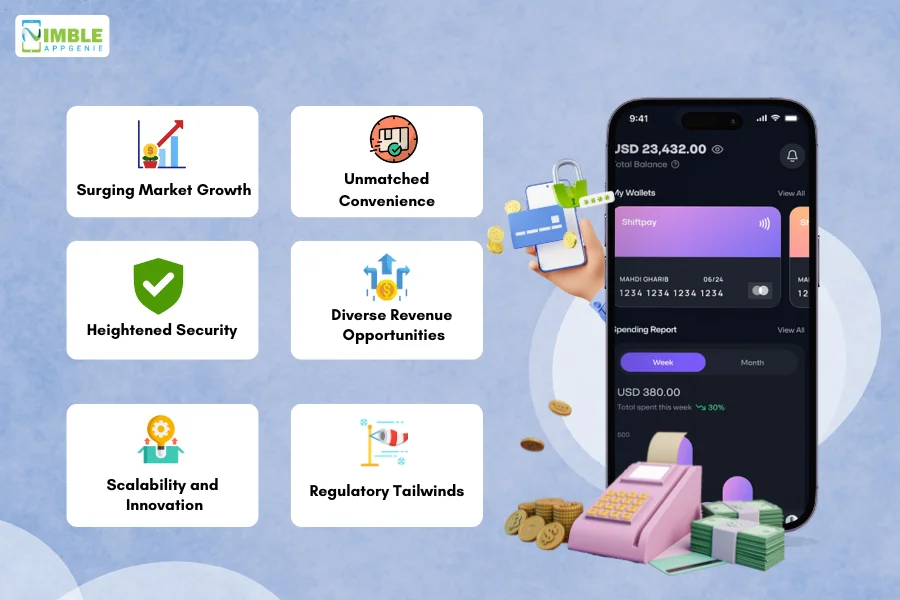
Here are some top reasons for businesses to invest in mobile apps:
1. Surging Market Growth
The market for mobile wallet businesses is booming across the world.
The global digital wallet market, valued at USD 1.04 trillion in 2019, is projected to reach USD 7.58 trillion by 2027, growing at a CAGR of 28.2% from 2020 to 2027.
This exponential growth is a clear indicator of the burgeoning demand for digital payment solutions.
2. Unmatched Convenience
Digital wallets streamline mobile payments, making them faster, easier, and more convenient.
A study showed that 84% of consumers are more inclined to shop with retailers that offer their preferred payment method.
This underscores the importance of digital wallets in the current retail landscape.
3. Heightened Security
With cybercrime on the rise, eWallets offer a safer alternative through advanced security features like tokenization and biometrics authentication.
Reports indicate that digital wallets can significantly reduce fraud, with a 67% decrease in fraud loss rates compared to traditional payment methods.
4. Diverse Revenue Opportunities
The e-wallet ecosystem allows for various revenue models, including transaction fees, which are expected to contribute significantly to the market’s growth.
Merchant services and value-added services within digital wallets also present lucrative revenue streams.
5. Scalability and Innovation
The mobile wallet space is ripe for innovation, allowing businesses to introduce features like loyalty programs, financial management tools, and cross-border payments.
Such innovations not only enhance user engagement but also open doors to scaling your business across different regions and demographics.
6. Regulatory Tailwinds
With governments worldwide advocating for mobile payments to enhance financial inclusion and reduce reliance on cash, the regulatory environment is increasingly favorable for digital wallet businesses.
Initiatives like the European Union’s PSD2 regulation are aimed at fostering an open and secure digital payments ecosystem.
Starting an eWallet business today means tapping into a market that’s not only vast but also growing at an unprecedented pace.
By leveraging cutting-edge technology and focusing on delivering value to users, entrepreneurs in the digital wallet app development sector can build scalable, secure, and successful digital wallet solutions that meet the evolving needs of a global audience.
Speaking of which, let’s look at the things that you need to do before starting a digital wallet business.
Things to Do Before Starting a Digital Wallet Business
Before diving into the vibrant and competitive world of digital wallets, it’s crucial to lay a solid foundation.
Preparing meticulously can set your eWallet business apart and position it for success.

Here’s what you need to do:
► Market Research and Analysis
The first step is to understand the eWallet landscape.
That’s where mobile app market research comes in.
Here, you need to analyze market trends, identify key players, and pinpoint your target audience. Look into demographic preferences, common pain points, and unmet needs.
Data-driven insights will inform your business strategy and product development.
► Define Your Value Proposition
This is the time to come up with a USP (unique selling point)
What makes your digital wallet stand out?
Is it superior security features, user-friendly design, unique functionalities, or integration with various services?
Clearly defining your unique selling points (USPs) will help attract users and investors alike.
► Regulatory Compliance and Legal Framework
Navigating the complex fintech regulatory environment is critical.
Understand the legal requirements of your target markets, including licensing, data protection laws, and anti-money laundering (AML) regulations.
For this, you can also consult with legal experts or RegTech firms to ensure full compliance.
► Secure Funding
App development cost isn’t cheap.
If you are planning to start a business in the eWallet market, you need funds. So, start by assessing the financial requirements to launch and scale your eWallet business.
Explore “how to get app funding” options like venture capital, angel investors, crowdfunding, or bootstrapping.
A robust business plan and clear revenue model will be vital in securing investment.
► Build Strategic Partnerships
If you want to become the next big eWallet company, you need to forge alliances with financial institutions, payment processors, merchants, and technology providers.
Why not?
Partnerships can enhance your service offerings, expand your user base, and provide technological and infrastructural support.
► Technology Infrastructure
Decide on the technological backbone of your eWallet. Consider factors like scalability, security, and compatibility.
Whether you opt for blockchain, cloud services, or traditional databases, ensure your technology stack is robust and future-proof.
► User Security and Privacy
When speaking of the digital wallet business, user security and privacy are paramount.
That’s why, before anything else, we implement advanced encryption, two-factor authentication, and other security measures.
Building a reputation for reliability and trust is essential in the financial services sector.
► Branding and Marketing Strategy
Develop a strong brand identity and a comprehensive marketing plan.
Your branding should resonate with your target audience, while your marketing strategy should leverage both digital and traditional channels to create awareness and engagement.
By meticulously addressing these preliminary steps, you’re not just preparing to launch a digital wallet business; you’re setting the stage for a sustainable and impactful venture in the fintech landscape.
Product: Steps To Create A Digital Wallet
With the preparations done, it’s time to focus on the product.
Now, we create an eWallet app.
Developing an app connects your business to billions of potential customers from across the world, opening doors to revenue in the millions.
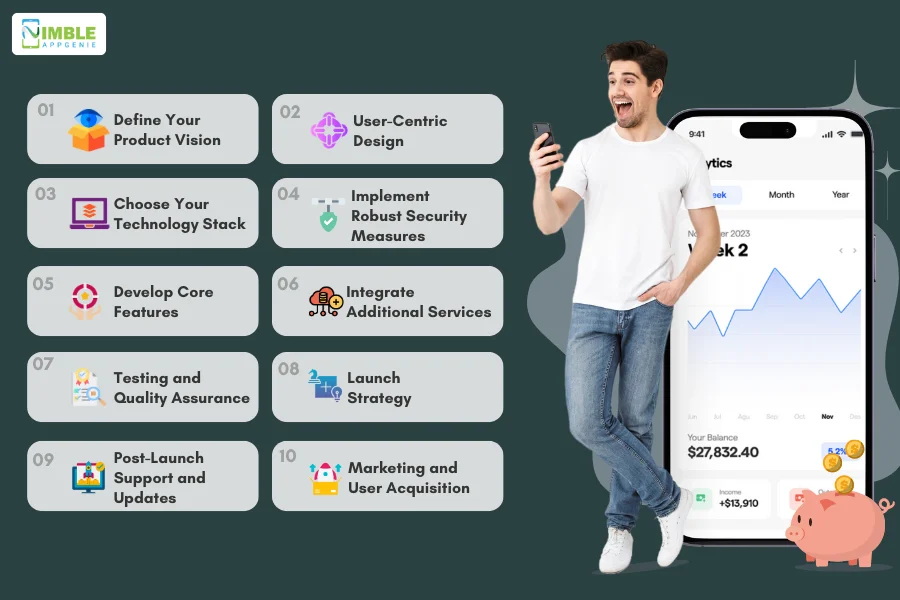
Speaking of which, here’s how you do it:
Step 1: Define Your Product Vision
Start with a clear vision of what your eWallet will offer, or what we call an eWallet business idea.
This includes the core functionalities, target user base, and how it differentiates from existing eWallet businesses & solutions.
Your product vision will guide all subsequent development efforts.
Step 2: User-Centric Design
eWallet app’s design is crucial.
The success of your eWallet app hinges on its user experience (UX) and user interface (UI).
Therefore, design the application with the user in mind, focusing on simplicity, intuitiveness, and ease of use.
Conduct user research and usability testing to refine your design based on real feedback.
Step 3: Choose Your Technology Stack
It’s time to focus on eWallet app tech stack.
Selecting the appropriate technology for your eWallet application is very important. The reason is, it affects everything from development costs to performance.
For those who don’t know, a tech stack includes front-end and back-end development platforms, databases, and security protocols.
Consider future scalability and integration capabilities with other systems and services.
Step 4: Implement Robust Security Measures
eWallet security is non-negotiable in financial applications.
Incorporate advanced encryption, secure authentication methods, and fraud detection systems. Regular security audits and compliance with industry standards (like PCI DSS) are crucial.
Step 5: Develop Core Features
The digital wallet’s features can make or break the app.
Therefore, it’s advised to focus on developing features that address your users’ primary needs.
This typically includes account registration, bank account linking, balance checks, peer-to-peer transfers, payment processing, and transaction history.
Step 6: Integrate Additional Services
Take your digital wallet product to the next level via integration.
To enhance value, integrate additional services like bill payments, mobile recharges, loyalty programs, and financial analytics.
These features can increase user engagement and set your eWallet apart.
Step 7: Testing and Quality Assurance
Rigorous testing is essential to ensure the reliability and performance of your eWallet app.
Conduct various tests, including functional testing, performance testing, security testing, and user acceptance testing (UAT).
Step 8: Launch Strategy
It’s time to launch the app.
Plan a phased rollout of your eWallet app, starting with a beta version to gather initial user feedback.
Use this feedback to make the necessary adjustments before a full-scale launch.
Step 9: Post-Launch Support and Updates
It’s time for app maintenance and support services to kick in.
After launch, continuously monitor your app’s performance, address user queries, and fix any issues promptly.
Regular updates are vital to keep your app relevant and secure.
Step 10: Marketing and User Acquisition
A robust marketing strategy is essential to attract users to your eWallet.
Utilize digital marketing, social media, influencer partnerships, and PR campaigns to build awareness and drive adoption.
By following these steps, you can develop a digital wallet that not only meets the market demand but also offers a secure, user-friendly, and innovative solution to your target audience.
Lesser and Larger Challenges That You Might Face
Launching an eWallet business is exciting, but it’s not without its hurdles.
Let us tell you that there are a lot of development challenges in eWallet app.
Being aware of potential challenges, both minor and significant, can prepare you for a smoother path to success.
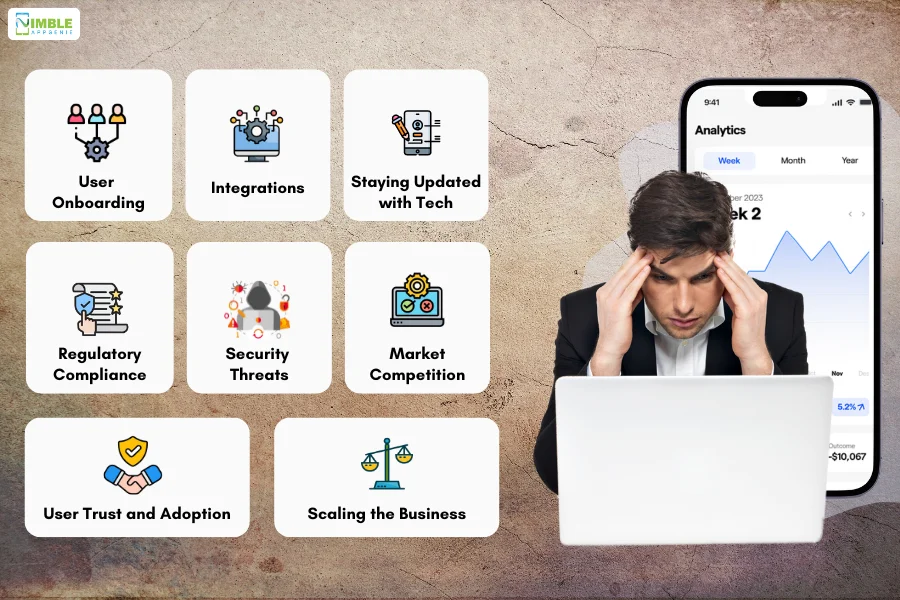
Here’s what you might encounter:
-
User Onboarding
Convincing users to try a new eWallet app and ensuring a seamless onboarding process can be tricky. Simplifying the sign-up process and providing clear, immediate value can help overcome initial resistance.
-
Integrations
Seamless integration with various payment gateways and financial institutions is crucial, but can present technical and bureaucratic challenges. Prioritizing key integrations based on your target market can streamline this process.
-
Stay Updated with Tech
The rapid pace of technological advancements means continuously updating your app to keep it secure and functional, which requires ongoing investment and effort.
-
Regulatory Compliance
Navigating the complex landscape of digital payment regulations and ensuring compliance can be daunting. This includes meeting KYC, AML, and other financial services standards, which vary by region and require significant legal expertise and resources.
-
Security Threats
As a financial service, eWallets are prime targets for cyberattacks. Implementing and maintaining state-of-the-art security measures to protect user data and funds is a significant challenge, but non-negotiable.
-
Market Competition
The eWallet space is crowded with established players and new entrants vying for market share. Differentiating your service with unique features, an exceptional user experience, and strategic marketing is crucial to stand out.
-
User Trust and Adoption
Building trust among users to switch from traditional payment methods to your digital wallet requires demonstrating tangible benefits, robust security, and reliability. User education and positive user experience are key to fostering trust and adoption.
-
Scaling the Business
As your user base grows, scaling operations, customer service, and infrastructure while maintaining service quality and security can be challenging. Strategic planning and scalable solutions are essential for managing growth effectively.
Top eWallet Businesses for Inspiration
The market is filled with super famous eWallet apps, generating billions in revenue for their businesses.
If you want to truly learn how to start an eWallet business, learn from the best.
That’s why in this section of the blog, we shall be going over the top digital wallets and what makes them stand out from the rest.
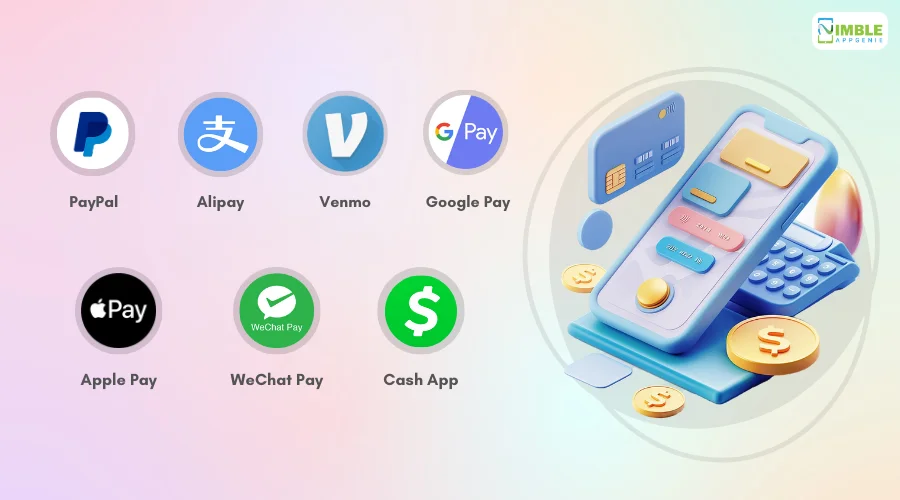
They are, as mentioned below:
1. PayPal
One of the pioneers in digital payments, PayPal has evolved from a simple payment processor to a comprehensive financial services platform.
It stands out for its ease of use, widespread acceptance, and robust security measures.
PayPal’s success lies in its ability to adapt and expand its services, including peer-to-peer transfers, online shopping, and business accounts.
2. Alipay
As the leading digital wallet in China, Alipay is a prime example of a super-app that integrates payments, investments, loans, and insurance services into a single platform.
Its success is attributed to its seamless integration with a wide range of services, from online shopping platforms to brick-and-mortar stores, making it an indispensable tool for millions of users.
3. Venmo
Popular among younger demographics, Venmo has made peer-to-peer transactions social and convenient.
Its user-friendly interface and social feed, where transactions can be shared and commented on, have fostered a strong community feel, making it more than just a payment app.
With this inspiration, you can create your own app like Venmo.
4. Google Pay
Leveraging Google’s ecosystem, Google Pay offers a seamless payment experience across online, in-app, and in-store purchases.
Its integration with other Google services, such as Gmail and Google Assistant, provides a cohesive user experience, making it easy for users to adopt and use regularly.
5. Apple Pay
Known for its emphasis on security and privacy, Apple Pay has set the standard for NFC-based payments.
Its seamless integration with Apple devices and the convenience of paying with a glance or a fingerprint have made it a popular choice among iOS users.
That’s why so many people want to create an app like Apple Pay.
6. WeChat Pay
WeChat Pay demonstrates the power of integrating digital wallet functionality within a social network.
This integration has enabled WeChat Pay to become a part of daily life for its users, facilitating everything from utility payments to in-store purchases.
7. Cash App
Want to develop an app like Cash? Well, you must first understand what makes it stand out.
Square’s Cash App has made financial transactions straightforward and accessible, with features like direct deposits, stock investments, and Bitcoin trading.
Its innovative approach to financial services, catering to both individuals and businesses, showcases the potential for digital wallets to transcend traditional banking.
Cost to Start an eWallet Business
Starting an eWallet business involves various financial considerations, from initial development costs to ongoing operational expenses.
The cost to develop an eWallet app ranges from $25,000 to $100,000.
However, the total cost can vary significantly based on the scale, features, and market you’re targeting.
Here’s a breakdown to give you an idea of the financial commitments involved:
| Expense Category | Cost Range | Details |
| Market Research and Business Planning | $5,000 – $20,000 | Hire market research firms and consultants to understand the market and plan the business. |
| Technology and Infrastructure | $50,000 – $150,000+ | Develop the app’s front-end, back-end, database, security measures, and integration with payment gateways. |
| Legal and Compliance | $10,000 – $50,000 | Legal fees for ensuring compliance with regulations (KYC, AML, PCI DSS, etc.) and intellectual property protections. |
| Licensing and Partnerships | Varies | Costs associated with obtaining necessary licenses and forming partnerships with banks, payment processors, and other entities. |
| Initial Marketing and Branding | $10,000 – $50,000 | Investment in branding, website development, and initial marketing campaigns to build awareness and attract users. |
| Operational Expenses | Varies | Includes staff salaries, office space, utilities, software licenses, and other day-to-day expenses for running the business. |
For a more detailed cost breakdown, you must consult an app development company.
Speaking of cost, let’s see how you can generate this investment back, and multiple times, in the section below.
How Your eWallet Business Can Make Its First Million: Monetization Strategies
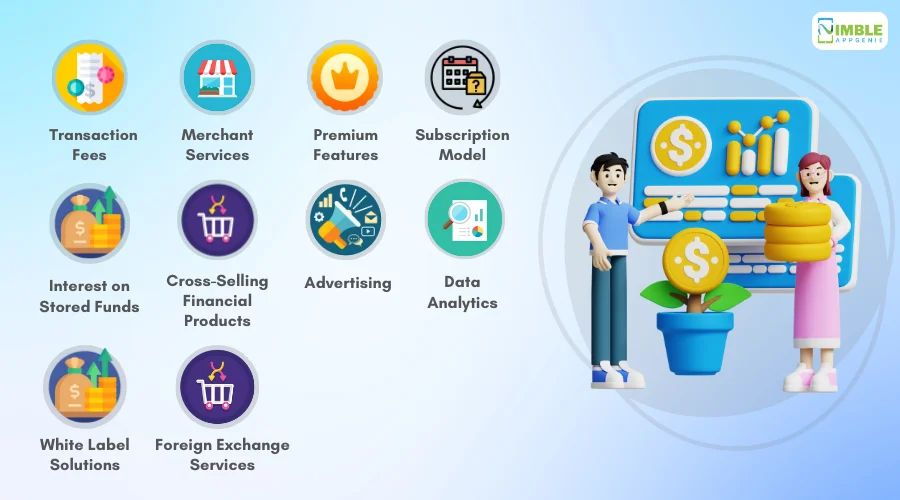
Achieving the first million in revenue is a significant milestone for any eWallet business.
This goal is attainable by implementing effective e-wallet app monetization strategies tailored to your market and customer base.
Below, we explore several proven methods to help your eWallet venture reach this critical financial threshold.
-
Transaction Fees
Charging a small fee for transactions processed through your eWallet can accumulate substantial revenue. This could be a percentage of the transaction amount or a fixed fee. To remain competitive, ensure your fee structure is transparent and provides value for the services offered.
-
Merchant Services
Partnering with merchants to facilitate transactions can open up a revenue stream through service fees. Offering merchants tools for transaction management, customer insights, and loyalty programs can justify these fees and encourage adoption.
Also Read: Merchant Service Provider
-
Premium Features
Offer basic eWallet functionalities for free while charging for premium features. These could include higher transaction limits, enhanced security features, or advanced financial management tools. This strategy can attract a broad user base while generating revenue from those seeking advanced capabilities.
-
Subscription Model
A subscription model offers users enhanced services, such as zero transaction fees, priority customer support, or exclusive deals, for a recurring fee. This will ensure steady revenue and user engagement.
-
Interest on Stored Funds
If regulatory conditions permit, earning interest on the aggregate funds stored in users’ eWallets can be a significant revenue source. This requires careful management and transparency to maintain user trust.
-
Cross-Selling Financial Products
Leverage your user base to offer related financial products such as loans, insurance, or investment opportunities. Collaborating with financial institutions can provide commissions or shared revenue from these products.
-
Advertising
Displaying targeted ads within your eWallet app can generate advertising revenue. Ensure that ads are relevant and non-intrusive to maintain a positive user experience.
-
Data Analytics
Anonymized user data can be valuable for market research and targeted advertising. Selling insights derived from transaction patterns and user behavior, while respecting privacy laws and user consent, can be a lucrative revenue stream.
-
White Label Solutions
Offer your eWallet platform as a white-label solution to other businesses. This allows you to leverage your technology and infrastructure to generate revenue without the direct cost of acquiring end-users.
-
Foreign Exchange Services
For eWallets, facilitating cross-border transactions and offering competitive foreign exchange rates can be a source of revenue. Transparently displaying exchange rates and fees can attract users who regularly transact in multiple currencies.
Implementing these monetization strategies requires a careful balance between generating revenue and providing value to your users.
It’s crucial to continually assess the market, listen to user feedback, and adapt your strategies to ensure your eWallet business not only reaches but surpasses the first million in revenue.
Nimble AppGenie, Your eWallet Business Partner
Do you want to start an eWallet business?
We’ve got you covered.
Nimble AppGenie is a market-leading eWallet app development company. We have helped more than 250 clients across the globe convert their ideas into reality.
Boasting 98% client satisfaction, we know what it takes to create the next best app for your business.
It’s high time to hire an app developer and turn your idea into a business product.
Conclusion
Starting an eWallet business in today’s digital age offers a lucrative opportunity given the market’s rapid growth and technological advancements.
By understanding market dynamics, ensuring regulatory compliance, and focusing on innovative, user-centered solutions, entrepreneurs can navigate this competitive space successfully.
Partnering with experienced developers like Nimble AppGenie can further enhance your journey towards creating a secure, user-friendly, and profitable eWallet app.
FAQs
The eWallet market is driven by the global increase in smartphone usage, a shift towards cashless transactions, and the demand for more secure and convenient payment methods. Statista predicts the digital payments market will exceed $10 trillion by 2026.
eWallets offer enhanced security features, such as tokenization and biometrics, making them safer than traditional payment methods. With a 67% decrease in fraud loss rate compared to conventional payments, eWallets represent a more secure future for transactions.
Starting a digital wallet business offers the potential for substantial growth, access to diverse revenue streams, and the opportunity to innovate in a tech-driven market. Additionally, the supportive regulatory environment and the global trend towards financial inclusion make it a timely venture.
Key steps include conducting thorough market research, defining a unique value proposition, ensuring regulatory compliance, securing funding, building strategic partnerships, and focusing on a robust technology infrastructure.
Initial costs can range from market research and business planning ($5,000 – $20,000) to technology and infrastructure development ($50,000 – $150,000+). Additional expenses include legal compliance, partnerships, marketing, and operational costs.
Industry leaders like PayPal, Alipay, Venmo, Google Pay, and Apple Pay have set high standards in terms of user experience, security, and market penetration. These companies offer valuable insights into successful strategies and innovations in the eWallet space.
Strategies include charging transaction fees, offering merchant services, providing premium features, earning interest on stored funds, cross-selling financial products, displaying ads, selling data analytics, adopting a subscription model, providing white-label solutions, and offering foreign exchange services.

Niketan Sharma is the CTO of Nimble AppGenie, a prominent website and mobile app development company in the USA that is delivering excellence with a commitment to boosting business growth & maximizing customer satisfaction. He is a highly motivated individual who helps SMEs and startups grow in this dynamic market with the latest technology and innovation.
Table of Contents




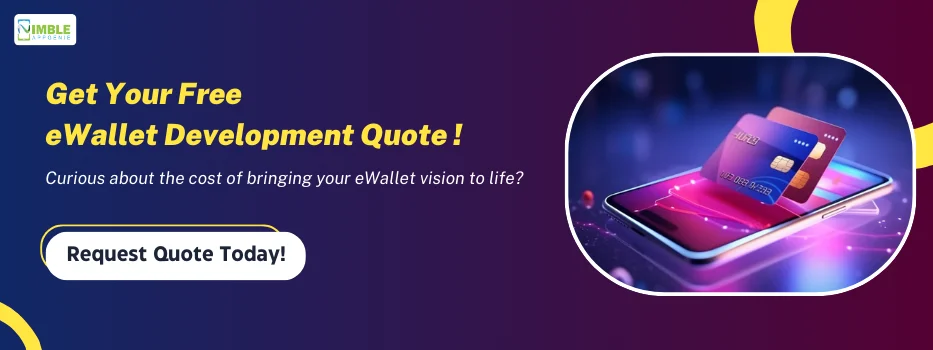
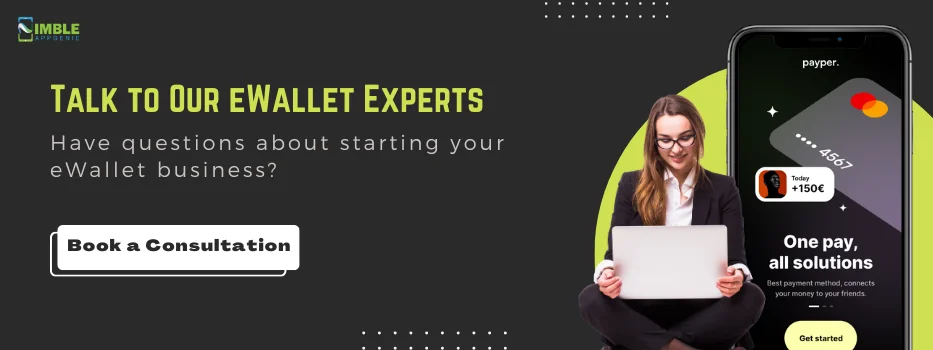
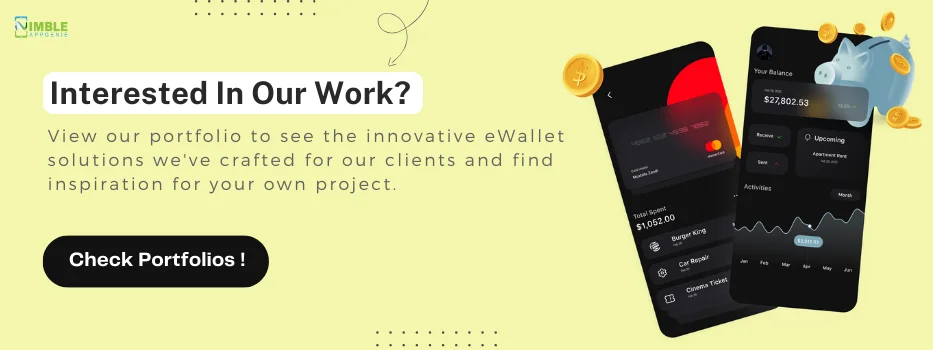
No Comments
Comments are closed.